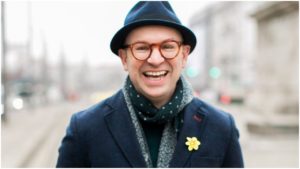
Q & A: Director Thomas Guthrie On Utilizing Puppetry For ‘L’Orfeo’
By David Salazar(Credit: Theresa Pewal)
When audiences check out Monteverdi’s “L’Orfeo” on July 5 and 7, 2019 at the York Early Music Festival and LOS St. Luke’s London, they will see the iconic opera utilizing puppetry and ancient Greek theatrical techniques.
Developed under director Thomas Guthrie, with the cooperation of students at Princeton University, these techniques will showcase one of the Guthrie’s great passions as a creator.
Guthrie is a former Jette Parker Young Artist Stage Director at the Royal Opera House in London and has worked on a number of productions at the Longborough Festival Opera. He is set to appear at the Liceu for a new staging of “Aida” and will also stage “Semele” with Sir John Eliot Gardiner.
Guthrie recently spoke to OperaWire about developing this new vision for “L’Orfeo.”
OperaWire: Can you talk about your first experience with opera?
Thomas Guthrie: My parents used to take me to Opera North. I quite enjoyed it, but didn’t really like the singing. Too wobbly, sometimes out of tune – I didn’t really get it. Now I do. Now I understand that it can be one of the most visceral and human ways to tell a story, especially one that deals with the extremes of human experience. And I think puppets can really help us understand that.
OW: In your view, what makes “L’Orfeo” a great opera?
TG: The way Monteverdi sets text, and the way his music is integral to the storytelling.
OW: Do you have a favorite moment in “L’Orfeo?”
TG: I have two: the music when Eurydice says goodbye for the last time (once Orpheus has turned round) and the music sung by Proserpina when she is thanking her husband Pluto for letting Eurydice leave. It is so sensual and touching (and he immediately takes her to bed!). But they only work in the context of the whole – it is a beautifully balanced thing of great wonder.
OW: Can you tell me a bit about the techniques you are employing for this production of “L’Orfeo?”
TG: Our approach to this production of “L’Orfeo” is the same as for any piece of theatre or opera we make: we are trying to inspire the audience’s imagination, to enable a personal, individual connection to the story and the music which can be amplified and intensified because it is happening in a room with a load of other people.
We are using puppets and masks, but those are just ancient theatrical tools that happen to be particularly good – especially with a piece like this, which is a myth told with wonderful music – at doing just that: inspiring our imaginations. They need us to project onto them, or they don’t work. But when we start doing that, when we engage, and believe that a movement suggested by the puppeteer or singer brings something we know to be just wood and cloth to life in front of us, our eyes and our ears both open not just to what we are experiencing but also to our own thoughts and feelings. We project ourselves onto the puppets, onto the characters, and into the story. That’s what theatre is all about.
OW: What about this specific opera inspired this approach and what do you feel you can express about the work through puppets?
TG: As I say, “L’Orfeo” is a myth, and myths are stories that externalize our inner workings. Using puppets helps us experience the story not just as something universal – which it is – but something deeply personal too. They also embody a detachment, a duality almost (puppet and singer, character and performer, doer and observer) which resonates with the way the mythological characters work. They are both fully functional characters and at the same time representations, symbols, signifiers, of deeper psychological truths. So they can work on a number of levels.
OW: How did you develop these puppetry techniques and what got you interested in puppetry to begin with?
TG: I first encountered puppetry as a performer when I was working with I Fagiolini in a production of Purcell’s “Indian Queen.” I was playing one of the servants, who acted out the story while the actors – the aristocratic home owners – read out the text. We used puppets – but as I remember it we were never very successful. It’s a real skill, takes great dedication and work, and despite our best efforts we never quite got the hang of it in the time we had.
But one of our cast, the wonderful singer Matthew Brook, played the character of Ismeron, a sorcerer, through a wonderful table top puppet. Ismeron had to emerge reluctantly from the depths of a cave, summoned to pronounce on a matter of great importance, to sing ‘Ye twice ten hundred deities’. Matthew sang while operating the puppet with great skill and attention. The combination of the singing, and the magic of the puppetry, was breathtaking.
A few years later, I had the opportunity to sing “Winterreise” in a wonderful old theatre (the Theatre Royal in Margate, second oldest in the country!), and I used the same technique. Since then I have used puppets in productions of “The Fairy Queen,” “Die schöne Müllerin,” “The Magic Flute,” “Dido and Aeneas” and now “L’Orfeo,” and worked with a number of puppeteers and puppet makers. Puppets aren’t gimmicks. They’re central to what makes theatre of all kinds (including opera) great: they engage our imaginations.
OW: What is the greatest challenge of puppetry that people may not be aware of?
TG: There is no challenge that doesn’t benefit everybody in the overcoming of it! It’s both a simple thing and infinitely detailed. The trick is to believe with every fibre of your being that it is alive, and then serve it.


